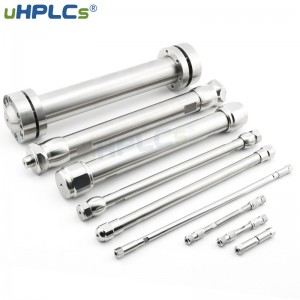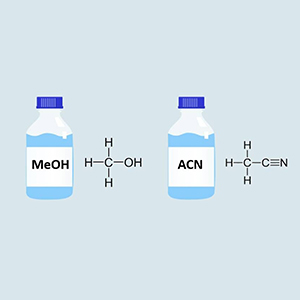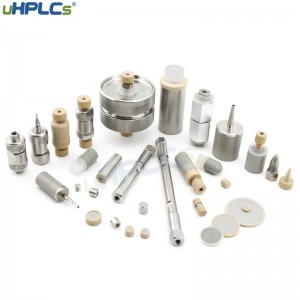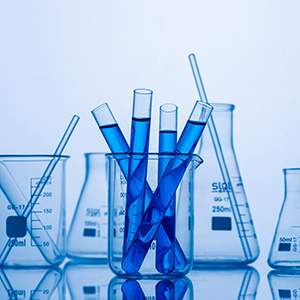The performance of the column plays a decisive role in whether the measured substances can be well separated and determined. Therefore, special attention should be paid to the column’s activation, and the column’s routine maintenance is also important. Effective maintenance can prolong the service life of the column.
The liquid chromatography columns are usually divided into normal-phase columns and reversed-phase columns. Most of the normal-phase columns are made of silica gel or bonded silica gel columns with functional groups such as -CN and -NH3 bonded on the surface of silica gel; reversed-phase columns are mainly packed with silica gel and bonded with non-polar octadecyl functional groups (ODS) on the surface called C18 columns, other commonly used reversed-phase columns include C8, C4, C2 and phenyl columns. There are also ion exchange columns, GPC columns, polymer packed columns, etc.
Activation of Chromatographic Columns
New liquid chromatography columns are stored in a specific preservation solution. The so-called activation is to replace the preservation solution and flush out other impurities that may remain in the column to avoid affecting the subsequent analysis. The activation method of liquid chromatography columns varies from column to column.
Reversed-phase column: When using a new C18 column, 20-30 column volumes are flushed with methanol or acetonitrile, then 10 column volumes are flushed with methanol/acetonitrile: water (50:50), and then 10-30 column volumes are equilibrated with the mobile phase.
Normal phase chromatography columns: New columns were equilibrated with mobile phase for 20-30 column volumes.
Ion chromatography columns (SAX, SCX): New columns are flushed with 100% methanol or ethane-nitrile for 20 column volumes and then converted to mobile phase equilibration.
The activation method varies from column to column and should be chosen according to the column type. In addition, it is important to remind that the column should not be connected to the detector during column activation to avoid unnecessary contamination.
Maintenance of liquid chromatography columns
There are certain procedures for the maintenance of chromatographic columns: equilibration of columns, regeneration of columns, and finally, the maintenance of columns.
1、Balancing of the chromatographic column
The reversed-phase chromatographic column is kept in acetonitrile/water after being tested by the factory. New columns should first be flushed with 10-20 times the column volume of methanol or acetonitrile. Always ensure that the mobile phase used to analyze the sample is miscible with acetonitrile/water. By spending enough time each day equilibrating the column with the mobile phase, you will get the most “compensation” for your problems, and your column will last longer!
Procedure:
a. Begin equilibration by slowly increasing the flow rate and equilibrating the column with the mobile phase until a stable baseline is obtained (buffer salts or ion-pair reagents will take longer to equilibrate if the flow rate is lower)
b. If the mobile phase contains buffer salts, attention should be paid to the “transition” with pure water. That is, before the start of each day’s analysis must be rinsed with pure water for more than 30 minutes before equilibrating the mobile phase with buffer salts; after the end of the analysis must be rinsed with pure water for more than 30 minutes to remove the buffer salts and then rinsed with methanol for 30 minutes to protect the column.
2, The regeneration of the column
With long-term use of the column, the column efficiency will often decline (theoretical column plate number is reduced). The column can be regenerated, so the conditional laboratory should use an inexpensive pump to regenerate the column.
Select the regeneration method:
Regeneration of polar stationary phases (e.g., Si, NH2*, DIOL-based chromatographic packing): n-heptane → chloroform → ethyl acetate → acetone → ethanol → water.
Regeneration of non-polar stationary phases (e.g., RP-18, RP-8, CN, etc. for reversed-phase chromatography packing): water → acetonitrile → chloroform (or isopropanol) → acetonitrile → water.
Notes:
a. When regenerating NH2-modified columns, since NH2 may be present in ammonium ions, it should be rinsed with 0.1M ammonia after aqueous washing and then rinsed with water until the alkali solution is completely run off.
b. 0.05M dilute sulfuric acid can be used to clean the contaminated column. If the simple treatment with organic solvent/water can not completely wash away the impurities adsorbed on the surface of silica gel after the water wash with 0.05M dilute sulfuric acid rinse is very effective.
3, the maintenance of chromatographic column
a. Use precolumn to protect the analytical column (silica gel has a certain solubility in polar mobile phase/ionic mobile phase).
b. The pH stability range of most reversed-phase columns is 2-7.5.Try not to exceed the pH range of the column.
c. Avoid drastic changes in the composition and polarity of the mobile phase.
d. The mobile phase must be degassed and filtered prior to use (solvent inlet filter).
e. If a polar or ionic buffer solution is used as the mobile phase, the column should be cleaned at the end of the experiment and stored in methanol or acetonitrile.
f. The chloride solvent is corrosive to it, so care should be taken when using it, and such solvent should not be kept in the column and connecting tube for a long time to avoid corrosion.
Precautions to be taken in the use of liquid chromatography columns
The storage solution of the liquid chromatographic column is the mobile phase shown in the evaluation report without special instructions. Before use, pay attention to the mutual solubility of the liquid chromatographic column’s storage solution and the sample’s mobile phase to be analyzed. In reversed-phase chromatography, if a high concentration of salt or buffer is used as eluent, a transition should be made with a low concentration of about 10% of organic phase eluent first; otherwise, the salt in the buffer will easily precipitate out in the high concentration of organic phase and block the column.
1, mobile phase
The various organic solvents used in the mobile phase should be as pure as possible, with the mobile phase of water preferably ultra-pure water or double distilled water in full glassware. If the mobile phase is filtered through a 0.45μm membrane, especially the mobile phase containing salt is better. In addition, mobile phase containers and in-line filters in chromatography systems should be cleaned or replaced regularly.
However, suppose you have both liquid and liquid phases in your laboratory. In that case, it is recommended that the mobile phase of the liquid phase not be easily cross-contaminated, or the liquid phase should be cross-contaminated with a special membrane instrument.
Mixing liquid phase and liquid mass with a permeation apparatus leads to triethylamine entering the mass spectrum and a sudden drop in response.
The pH range of conventional silica-based bonded phase packing is usually 2.0-8.0. When it is necessary to use the column under the boundary conditions of the pH range, wash the column immediately after each use with a solvent suitable for storage and soluble with the mobile phase used, and completely replace the mobile phase used.
The range of PH and column temperature is different for different packed columns.
2、Sample
The sample should also be as clean as possible. The sample filter or pretreatment column (spe) can be used to pretreat the sample; if the sample is inconvenient to handle, use a protective column. In the analysis of samples by normal phase chromatography, all solvents and samples should be strictly dehydrated.
General samples can be centrifuged at high speed. Still, you need to pay attention to taking the supernatant, do not take the precipitated material below as well as the chromatographic column before the best to add a pre-column or online filter.
3, reversed-phase liquid chromatography column maintenance every day after the experiment
The use of buffer or mobile phase containing salt, after the completion of the experiment, should be 10% methanol/water rinse for 30 minutes, wash off the salt in the column, and then rinse with methanol for 30 minutes. Note: The column should not be rinsed with pure water; 10% methanol should be added to the water to prevent the collapse of the packing.
4、Long-term preservation of chromatographic column
If the column is to be stored for a long time, it must be stored under a suitable solvent. For reversed-phase columns can be stored in pure methanol or acetonitrile, normal-phase columns can be stored in pure hexane after severe dehydration, and ion-exchange columns can be stored in water (with preservative sodium azide or thimerosal) and plugged with the plug that came with the purchase of a new column. The storage temperature should preferably be room temperature.
Post time: Sep-08-2022










